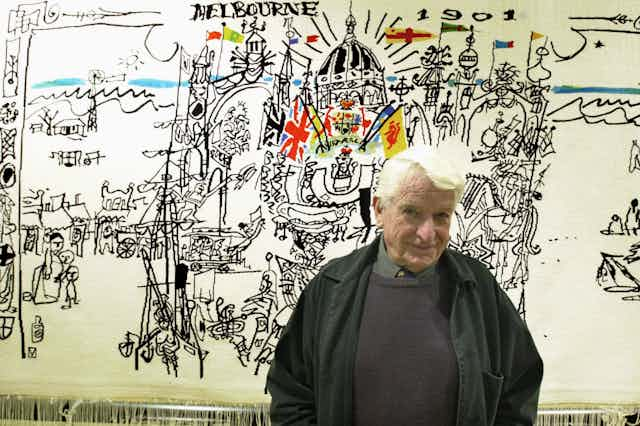After seven decades as a visual satirist provoking Australia as it is and might be, Bruce Petty passed away at 93 on April 6 this year.
His career as a political cartoonist started with a trip to London in the late 1950s, then a stint at young Rupert Murdoch’s afternoon paper in Sydney, the Mirror.
He had a lead role as The Australian’s political cartoonist during the newspaper’s radical first decade, until it turned right during the Whitlam dismissal and Larry Pickering was promoted to favoured cartoonist.
Petty then moved to The Age in its glory days, where he was the acknowledged godfather of the troupe of brilliant cartoonists there at the time. He stayed until 2016, with Malcolm Turnbull his last prime minister, by which time the collapse of the broadsheet model was well advanced.
Throughout the decades, he moonlighted as an animator and author of books we might now call graphic essays or even novels, always at the cutting edge of thought and technology.
Inevitably, profiles stress he won an Academy Award for animation with Leisure (1976), but his deepest cultural intervention in the story of post-Menzies Australia came during the Vietnam War years. Australia changed and he was one of the major prophets of change.
With a handful of others like Les Tanner and George Molnar, he woke editorial cartooning from a sleepy period telling fairly anodyne jokes and turned it into a mode of serious – if also often hilarious – satirical commentary on politics and society.
Read more: The Australian helped political cartoonists sharpen their edge
In the vanguard
Flinders University Museum of Art has a remarkable collection of 73 cartoon originals and sketches from Petty’s most formative period. They were a characteristically generous gift by the artist, for a university then only three years old, and solicited by inaugural fine arts lecturer Robert Smith.
Among them are these five particularly vivid cartoons published in The Australian between May 1966 and September 1967.
These fragile objects, sometimes stuck together with glue when he changed a line of thought, take us straight into the maelstrom of the Vietnam War before the moratorium marches, when Prime Minister Harold Holt won the 1966 election in a landslide.
Petty was in the vanguard of a small but vocal opposition, drawing the war as a deep tragedy for the Vietnamese and a reckless farce perpetrated by the West.
One cartoon, Getting there is half the fun, about President Lyndon B. Johnson’s imperial triumph of a visit to Australia, marks the contrast.

The jagged black blob, which covers about half of the box, colours the movement from farce to tragedy arrestingly black.
Petty’s busy line attracted more than its fair share of the “my grandchild could draw better than that” sort of criticism, but it was entirely deliberate and brilliantly expressive. He doesn’t aim to please visually. He wants to stop readers with a shock of the unfamiliar and make them think. He is also a humane but stern critic of fools and villains.
Look at Hospitals – regrettable, but in the name of democracy, don’t hit a polling booth.

Are Johnson and his adipose generals conscious villains, or merely fools being driven by murderous ideas and scarcely sublimated self-interest?
I think Petty gives them the benefit of the doubt, just. But then he drives home the fact that being venal fools does not excuse them from the crime of bombing innocent people.
Read more: The forgotten Australian veterans who opposed National Service and the Vietnam War
Intimate sympathy
Something similar happens with the privileged women under the hairdryers in the cartoon, Who says we women aren’t interested in politics?

Is this the moral fecklessness of consumer society projected onto women, or is it the dawn of concern for the people ravaged by a needless imperial war? As so often for Petty, it is both.
A large part of the power of these cartoons comes from Petty’s deep engagement with people forced to live with the war. His first book, Australian Artist in South East Asia (1962), is a graphic account of his journey through seven countries. He went to Vietnam again during the war as a cartoonist-correspondent.
He is drawing the Other – how could it be otherwise for a still White Australian audience? – but he is doing it with an intimate sympathy born of real knowledge.

I must say, I’ve found the first day of democracy a little disappointing is a wry and ironic cartoon about the debauched South Vietnamese election then under way, but it takes you to the people actually affected.
Finally, Peace Feeler, published in 1967.
Johnson talked peace with South Vietnamese generals in Honolulu, even while continuing to bomb the Viet Cong with huge and brutal firepower.
Publish this cartoon unchanged today, and everyone would see it as about the war in Ukraine. Sadly, great satire like Petty’s keeps finding its moment.

Read more: Friday essay: political cartooning – the end of an era

